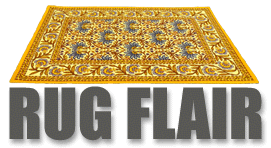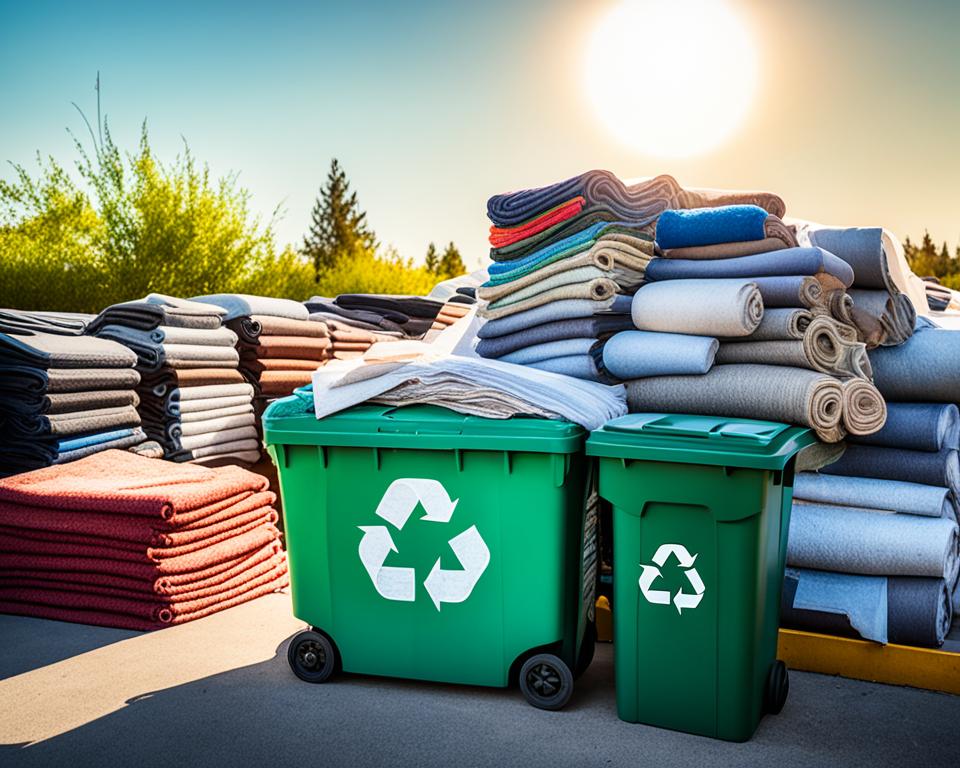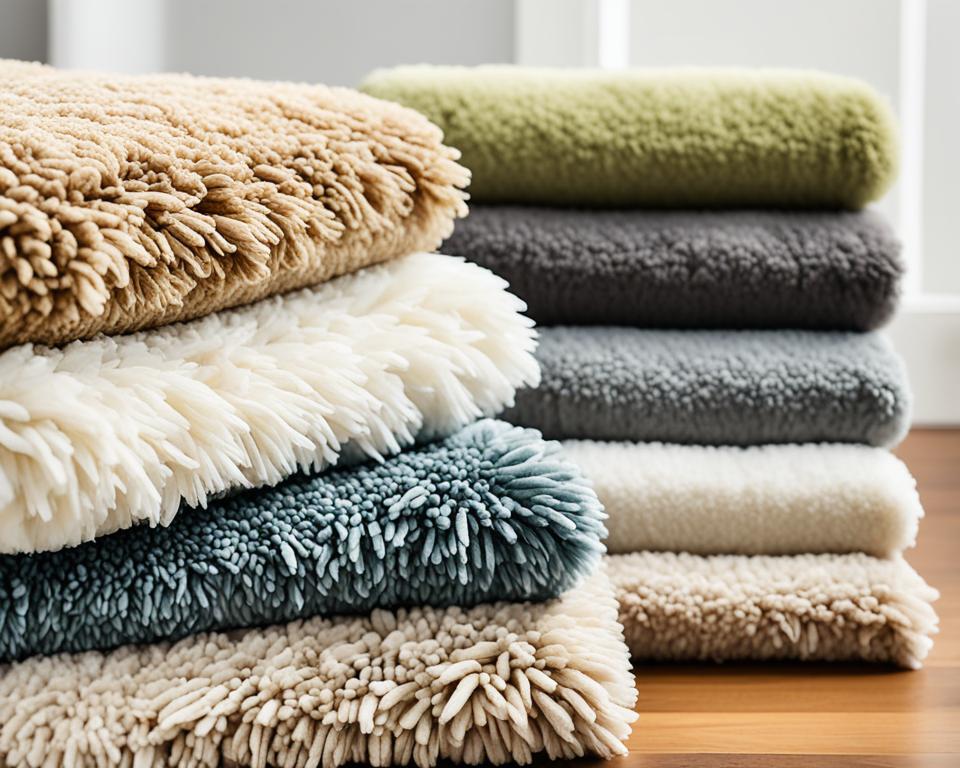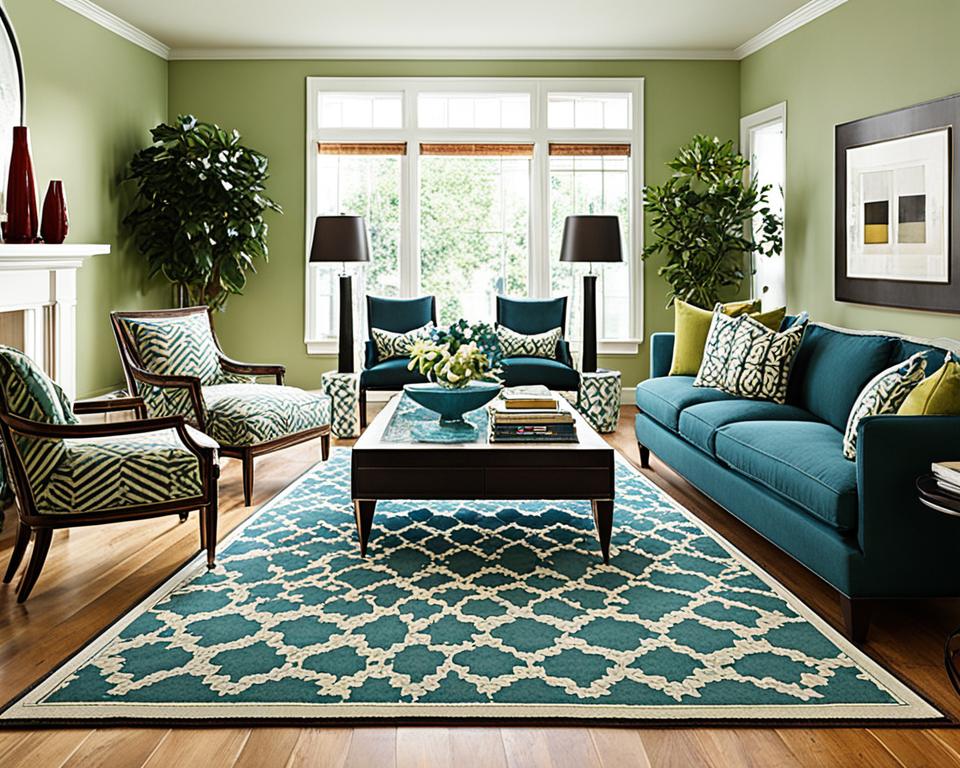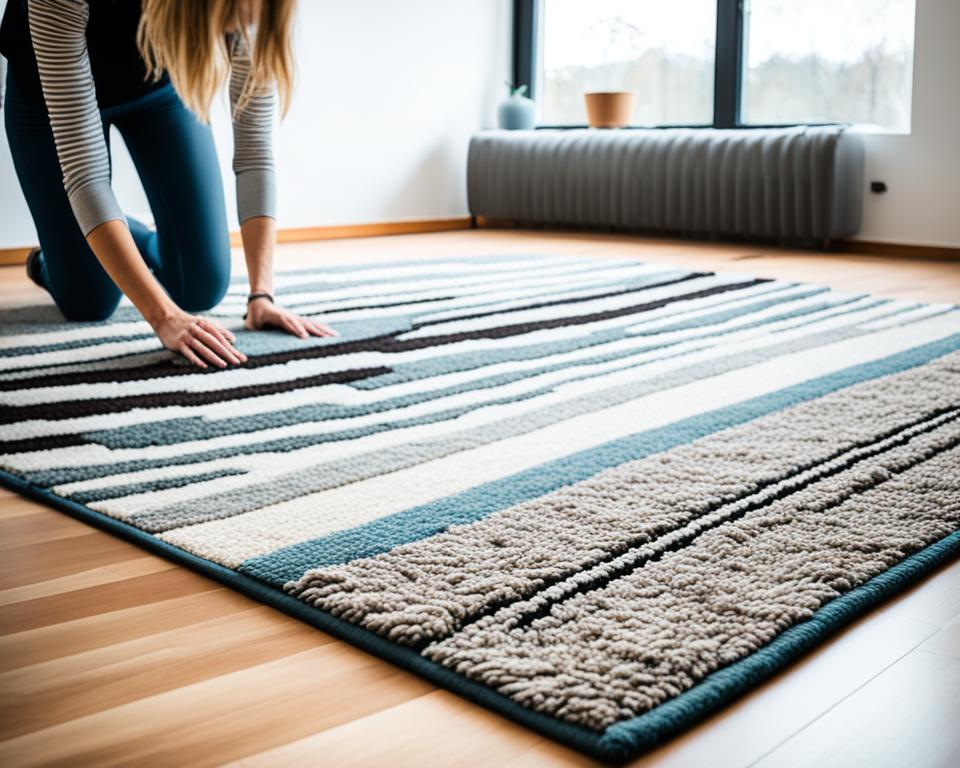When you find yourself at a crossroads with an aged rug, pondering whether are rugs recyclable, you’re already a step closer to embracing eco-friendly rug disposal. The pathway to sustainable living doesn’t have to end at the landfill. Your trusty ol’ rug could embark on a second journey, offering warmth and comfort under new feet, instead of contributing to waste accumulation.
A rug in decent nick might find solace in the welcoming arms of a local charity shop, or maybe it could become an unexpected treasure for a thrifter, thanks to your post on an online marketplace. The possibility for rehoming is vast and aligns with your vision of waste reduction and sustainability.
Before you write off a rug that’s seen better days, let’s not forget the power of a good cleanse and mending. Sometimes, that’s all it needs to revive its splendor – not to mention the feel-good factor of saving precious pennies and extending the life cycle of your beloved textile. However, if the end is nigh, recycling is your eco-conscious swan song. With dedicated textile recycling facilities, you can ensure your rug’s components are ushered into a new existence, away from the confines of a trash heap.
Key Takeaways
- Donating or rehoming a rug is a cornerstone of eco-friendly rug disposal, embodying both waste reduction and support for those in need.
- Cleansing and repairing can breathe new life into your old rug, adding longevity and value.
- For rugs beyond salvation, dedicated recycling is a green victory, turning one’s old treasures into new resources.
- Keeping rugs out of landfills is key to preserving our environment, underscoring the importance of asking, “are rugs recyclable?“
- Your proactive choices in rug disposal can significantly contribute to a more sustainable future.
Understanding Rug Recycling and Its Importance
Are you aware of the complexity and vital nature of recycling old rugs? In this modern era, the push towards sustainable rug options is more pronounced than ever, prompting us to reassess how we dispose of household items. With landfills growing and the Earth’s resources dwindling, practicing environmentally friendly rug removal has become an imperative habit for the eco-conscious consumer.
Rugs and carpets embellish our homes, but they also symbolize a recycling challenge that demands our attention. Let’s delve into why rug recycling deserves to be prioritized and the systemic hurdles it faces.
The Challenge of Rug Disposal
When the time comes to replace an old rug, the question of disposal poses a significant challenge. The varied materials—fibers, adhesives, and plastics—used in rug manufacturing complicate the recycling process, rendering them ill-fitted for traditional waste systems. Municipal refuse services often reject these bulky and intricate items, and as a consequence, there’s an underlying urgency in finding alternative disposal methods that honor our environmental commitments.
The Environmental Impact of Non-Recycled Rugs
Alarming statistics from organizations like Carpet America Recovery Effort (CARE) reveal that an estimated 5 billion pounds of carpet found its way into landfills in 2017 alone. These non-recycled rugs are an ecological concern, having the potential to leach toxins and emit greenhouse gases for centuries before decomposing. As consumers and stewards of the planet, our role in diverting rugs from landfills by endorsing proper recycling of old rugs is clear and present. The sustainable practice of rug recycling disassembles these cast-offs into their constituent parts, reincarnating them into valuable commodities such as automobile parts and new flooring, and proving that responsible stewardship can be both practical and transformative.
Remember, every rug recycled is a step toward a cleaner, more sustainable planet.
Are Rugs Recyclable?
When pondering over sustainable rug options, one might wonder, “are rugs recyclable?” Indeed, the good news is that rugs generally can be recycled, marking a triumph for eco-friendly lifestyles and waste reduction. However, it’s not as simple as leaving them out with the rest of your single-stream recycling. While frustrating, the complexity of rugs – with their various materials intertwined into one – requires specialized attention when it comes to recycling.
Rug recycling is a detailed, step-wise process. Each rug is divorced into its raw materials – fibers, adhesives, backings, and more – in a manner engineered to reclaim its elements. These segregated materials can then begin their second life, reincarnated into a host of new products. Hence, recycling old rugs becomes not just a choice but an essential deed for the environmentally conscientious.
Let’s break down the journey of recycling old rugs:
- Rugs are collected and transported to recycling facilities.
- At these facilities, rugs are sorted by material type.
- Materials are then processed and broken down.
- The result? Recycled fibers and materials ready to be repurposed!
Turning to a recycling facility grants your aged rug a reprieve from the landfill and an entry ticket into the world of sustainable rug options. Your action here magnifies the lifecycle of the materials and underscores your personal commitment to an environment-friendly legacy.
Sourcing Eco-Friendly Rug Materials
With a world focused on sustainability, eco-friendly rug disposal isn’t only about the end of a rug’s life but also its inception. Innovative companies are leading the charge in providing sustainable rug options that are kind to our planet from the get-go. A key component of this is sourcing materials that minimize environmental impact and boost the recyclability factor. As an informed consumer, you play a pivotal role in this cycle of renewal.
The Rise of Recycled Content in Carpets
Among the frontrunners in sustainable innovation is FLOR, renowned for its distinctive carpet tiles. With a commitment to ecological integrity, FLOR’s products boast an average of over 65% recycled content, a figure that reflects an industry-wide shift towards recycling old rugs and materials. The use of Aquafil’s ECONYL® yarn, crafted entirely from regenerated nylon waste like fishing nets and fabric scraps, underscores the brand’s dedication to reducing reliance on new resources.

Benefits of Choosing Sustainable Rug Options
Opting for rugs with a high percentage of recycled content doesn’t just ease your conscience; it’s a tangible stride against global warming. Every sustainable rug in your living space signifies your contribution to a larger, greener movement. In harnessing renewable energy for production, companies like FLOR illuminate the path for consumers eager to make a positive impact through conscious purchasing decisions, reinforcing the query: “are rugs recyclable?” The answer is a resounding yes, beginning with the very fibers that weave together our homes’ most cherished adornments.
| Sustainable Rug Feature | Environmental Impact | Consumer Benefit |
|---|---|---|
| 65%+ Average Recycled Content | Less waste heading to landfills | Participation in a circular economy |
| Aquafil’s ECONYL® Yarn | Upcycling of nylon waste, preventing ocean pollution | Supporting innovation in sustainable materials |
| Renewable Energy Manufacturing | Reduction in carbon emissions | Smaller carbon footprint at home |
When you select sustainable rug options, you’re not simply decorating your home; you’re actively supporting a vision for a recyclable, reusable future. The integration of eco-friendly materials in rug manufacturing not only furthers eco-friendly rug disposal but also begins a narrative of mindful usage and responsible living. So the next time you tread across your rug, know that your choices reverberate through the ecosystem, proving that, yes, rugs are recyclable, and better yet, they can be born of recycled materials too.
Options for Eco-Friendly Rug Disposal
When the time comes for you to part with your old rug, consider environmentally friendly rug removal as your first option. It’s a conscious step ensuring that your home decor choices don’t adversely impact the environment. There are several green rug disposal solutions that not only divert rugs from filling landfills but also offer them a second life in a new home or form.
One of the simplest ways to give your rug a new beginning is to donate it. Functional rugs can serve many further years underfoot when donated to local charities, thrift stores, or community groups. By doing so, you not only contribute to sustainability but also aid those in need. Another popular and equally eco-friendly approach is to list your old rug on various online marketplaces, which is an excellent way of finding someone who might treasure it as much as you did.
For rugs that have moved beyond their prime, locating your nearest textile recycling facility or waste management point should be the next step. This ensures your rug’s fibers and materials don’t go to waste and instead become part of something new and valuable. Here is how green rug disposal solutions reflect respect for the environment:
- Your old rug avoids adding to the growing mound of refuse in landfills.
- Recycling centers can break down rugs into raw materials, yielding recycled content for manufacturing new products.
- Through eco-friendly rug disposal, you contribute to a circular economy, championing sustainability.
| Disposal Option | Environmental Benefit | Social Impact |
|---|---|---|
| Donation or Rehoming | Reduction of waste and need for virgin materials | Supports local communities and provides for those in need |
| Online Marketplace Listing | Extends the lifespan of the rug, delaying the need for disposal | Facilitates a peer-to-peer sharing economy |
| Local Recycling | Ensures materials are processed for reuse | Decreases communal reliance on landfill space |
By opting for any of these eco-friendly rug disposal paths, you’re effectively turning a simple household chore into an act of environmental stewardship. So before discarding that worn tapestry into the bin, pause and ponder the possibilities – your rug’s next chapter might just be the start of a greener future.
Repurposing Rugs: Giving Your Old Rug a New Life
Don’t retire your rug; repurpose it! The journey of your cherished floor covering doesn’t have to end once it has served its initial purpose. With a dash of creativity and environmentally friendly consideration, your old rug can assume new roles and continue to add comfort and aesthetic appeal in your home or someone else’s. Embracing the concept of repurposing rugs aligns with the environmentally friendly values of reducing waste and practicing sustainable living.
Upcycling Ideas and DIY Projects
Think outside the box and breathe new life into your worn-out rugs. There’s a wealth of potential locked in every fiber, just waiting to be unleashed through various DIY projects. Consider these crafty transformations that favor repurposing rugs:
- Turn a segment of your old rug into a cozy cat scratching toy to keep your feline friend entertained—and your furniture safe.
- Create a unique kitchen mat by binding together colorful scraps from your old carpet, combining utility with creative flair.
- Use slices of your former rug as protective padding under heavy exercise equipment, preserving floors and reducing noise.
- Re-install the rug in a lower-traffic area of your house, such as a basement or a workshop, for continued use.
As you can see, the possibilities for repurposing rugs extend beyond the conventional, saving you money and fostering an environmentally friendly rug removal process.
Donating Rugs: Where to Donate and What to Expect
If your rug is still in good shape, consider the generous act of donating it. Charities, secondhand stores, and community centers sometimes welcome rugs to enliven their spaces. This is what you need to know when donating your rug:
- Ensure the rug is clean and free of any damage or safety hazards before you donate.
- Contact the organization to confirm they accept rug donations, as some places may not due to health and safety policies.
- Donating your rug can provide comfort to those in need and keeps it out of the landfill, epitomizing eco-friendly rug disposal.
By choosing to donate or repurpose your old rugs, you’re not just clearing out space at home; you’re taking a responsible step towards sustainability and offering a gift of comfort that can greatly benefit others.
Recycling Old Rugs: How and Where to Recycle
Discovering the pathways for recycling old rugs is a commendable step towards eco-friendly rug disposal. Your household’s worn rugs need not end up as environmental burdens. Instead, they can embark on a new lifecycle when you tap into the specialized facilities geared to handle their transformation. It’s a proactive choice that echoes the notion, “are rugs recyclable?” Indeed they are, and here’s how you can contribute to their rebirth.
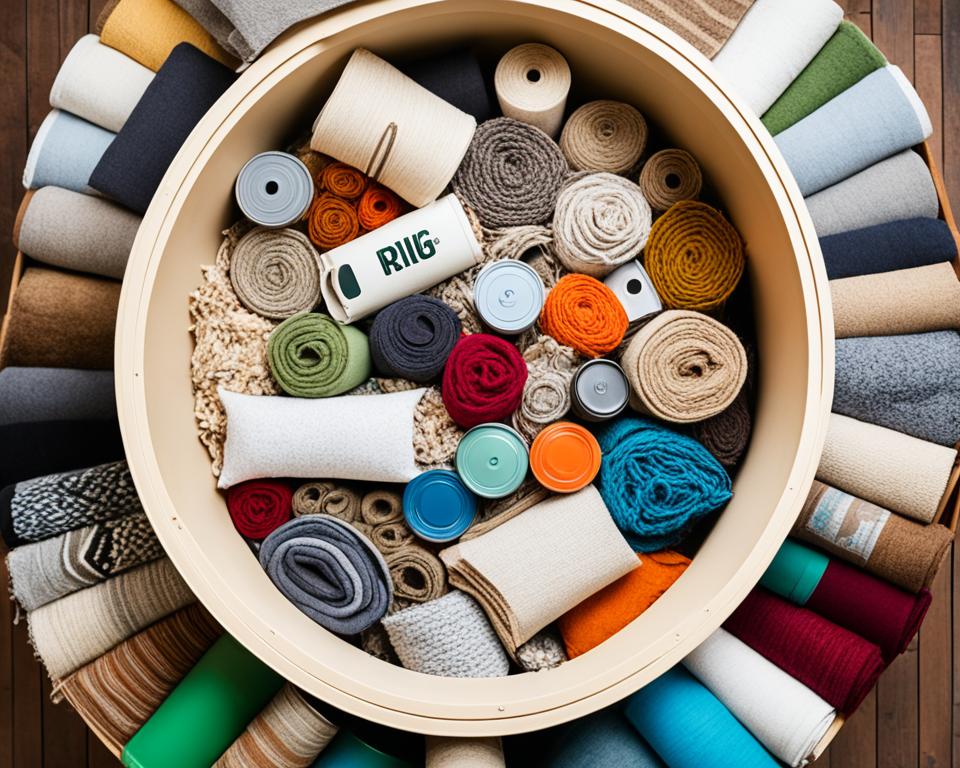
While your area may not have curbside recycling for these bulky items, there’s a network of facilities and programs designed for recycling old rugs. Start by contacting your local waste management services. They can provide guidance on reputable recycling options and inform you about the state-run programs specifically established for carpet recycling.
Organizations like Carpet America Recovery Effort (CARE) offer resources to help you locate carpet collection sites through their maps. Availability can vary by location, but with ever-growing eco-consciousness, more and more facilities are cropping up to aid in recycling old rugs.
Moreover, flooring retailers are increasingly joining the environmentally-responsible bandwagon. Some offer take-back programs, recycling your old carpet upon installation of new flooring. This seamless exchange not only simplifies the process but also ensures that your old rug is handed directly to experts in carpet recycling, making eco-friendly rug disposal all the more accessible.
And if you’re not in the market for new flooring? There are businesses that, for a fee, will take care of the entire process. They’ll pick up your old rug and ensure it reaches the proper recycling facility, regardless of its brand or origin, thus answering the question: “are rugs recyclable?” with a clear plan of action.
| Recycling Option | How It Works | Additional Notes |
|---|---|---|
| Local Waste Management | Provides location of rug recycling facilities | May offer pick-up for bulky items |
| CARE’s Collection Sites | Maps to identify nearby facilities | Focus on partnership and convenience |
| Flooring Retailers’ Take-Back Programs | Recycle old carpet upon new installation | Often no extra cost with new carpet purchase |
| Third-Party Services | Pick-up and delivery to recycling centers | A fee may be charged for service |
Remember, the next time you eye a faded rug, see it not as waste, but as a candidate for recycling. Through these eco-friendly rug disposal options, you’re not just tidying your space; you’re actively engaging in a greener lifestyle and supporting a system that affirms are rugs recyclable, with a robust “Yes”!
Green Rug Disposal Solutions: From Return Programs to Retailer Initiatives
Transitioning to a sustainable lifestyle involves mindful disposal of home furnishings, and understanding green rug disposal solutions is pivotal. As you seek sustainable rug options, recognizing that are rugs recyclable is only the first step—taking action through structured programs makes a tangible impact. Let’s examine the innovative initiatives that are making rug recycling easier and more accessible than ever.
Return & Recycle Programs in Action
Leading the pack in green rug disposal solutions, FLOR showcases a proactive approach through its Return & Recycle program. This initiative allows you to send back old carpet tiles to be recycled into new products—demonstrating that the life of a rug, indeed, goes beyond its initial use. Such programs are not only eco-friendly but offer a convenient method to contribute to sustainable rug options.
Consider the benefits of participating in a return and recycle program:
- It extends the life of carpet materials, avoiding unnecessary waste.
- You become part of a larger movement, contributing to a sustainable future.
- These programs often come with benefits, such as discounts on future purchases.
Partnering with Retailers for Responsible Disposal
Retailers have stepped up, recognizing their role in fostering eco-friendly rug disposal. By partnering up with sustainability champions like Aquafil, creators of ECONYL®, retailers offer a responsible end-of-life option for products, closing the loop on the product life cycle. Through such collaborations, retailers not only support green rug disposal solutions but also encourage you to engage in preservation of the environment with ease and confidence.
A snapshot of retailer initiatives:
- Many provide take-back programs, ensuring old rugs are precisely recycled.
- Some retailers offer discounts or incentives for returning old products.
- Incorporating materials like carbon-negative ECONYL® yarn reinforces a commitment to renewable energy and a diminished environmental footprint.
The collaborative efforts by retailers demonstrate how repurposing and recycling can be seamlessly integrated into the consumer experience. Your involvement in these initiatives supports environmental sustainability and amplifies the answer to the question: “are rugs recyclable?”
Advancements in Carpet Recycling Technologies
As we explore the sustainability journey within our homes, the question of are rugs recyclable becomes pivotal. With continuous advancements in carpet recycling technologies, innovative solutions to rug disposal have emerged, reflecting a robust commitment to the environment. These technological strides have significantly improved the efficiency and effectiveness of recycling programs, reshaping our approach to sustainable rug options.
Innovation in Carpet Reclamation
The dynamic field of carpet reclamation has seen impressive innovation, sparing countless rugs from languishing in landfills. Pioneering companies like Interface have embraced sustainable practices with tangible outcomes, boasting a portfolio of recycled content and renewable energy-powered manufacturing processes. FLOR, an Interface subsidiary, serves as a shining example with their high recycled content carpet tiles and their ambitious journey towards carbon negativity by 2040.
The Role of Non-Profit Organizations in Carpet Recycling
Non-profit organizations such as Carpet America Recovery Effort (CARE) play an indispensable role in scaling up carpet recycling capabilities. Following their lead, the industry has welcomed a steady uptick in carpet recycling infrastructure, bolstering communities’ ability to participate in eco-friendly rug disposal. CARE’s initiatives have been pivotal in educating the public and fostering a network that supports widespread adoption of sustainable rug options, making the once-daunting task of carpet recycling more approachable and actionable.
| Technology or Initiative | Impact on Recycling | Contributions to Sustainability |
|---|---|---|
| Aquafil’s ECONYL® Yarn | Enables continuous cycle of regeneration for nylon materials | Reduces dependency on virgin resources, minimizes ocean waste |
| FLOR’s Carbon Negative Products | Utilizes materials that sequester carbon, reversing emission footprints | Pushes industry boundaries to achieve carbon negative status |
| CARE’s Recycling Infrastructure | Develops accessible and efficient recycling pathways | Diminishes ecological footprint of carpet disposal, promotes circular economy |
| Interface’s Mission Zero™ | Realizes zero negative impact on the environment from operations | Marks a successful precedence in corporate environmental responsibility |
Your conscious choices today impact the rug you’ll stand upon tomorrow. With advancements in the industry and the unyielding effort of organizations like CARE, the question are rugs recyclable is met not just with affirmative answers, but with a range of sustainable rug options that uphold both aesthetic and environmental integrity. As you lay the groundwork for a greener home, take pride in knowing that the rugs beneath your feet are a testament to innovation, dedication, and a collective step towards a sustainable world.
Conclusion
In this journey through the nuances of eco-friendly rug disposal, we’ve uncovered a tapestry of options available for your old rug. It’s clear that your individual choices are pivotal in shaping a more sustainable future. Whether it’s selecting rugs crafted with recycled materials or engaging in green rug disposal solutions, each action you take has a ripple effect – reducing waste, preserving resources, and inspiring others to follow suit. So as you stand upon your cherished rug, remember that its fibers hold the potential for renewal and repurposing beyond their years underfoot.
Your Role in Sustainable Rug Management
Every rug you decide to recycle or repurpose makes a positive impact on our environment. The choice to invest in a rug born of sustainable practices or to participate in innovative repurposing rugs endeavors not only reflects your eco-conscious values but also plays a vital role in the growing arena of rug recycling. By acting as stewards of the earth in our households, we contribute to a broader movement towards ecological responsibility – one that starts at our doorstep.
Joining the Eco-Friendly Movement: Next Steps
Embarking on the path to green rug disposal solutions begins with staying informed about the myriad of sustainable options at your disposal. Seek out those brilliant initiatives and companies championing the shift towards a greener tomorrow. As you adorn your living spaces, envisage the lifecycle of each rug and make choices that support #EarthDayEveryDay. From your local community efforts to global sustainability goals, your endeavors in managing rugs responsibly carve out a healthier, cleaner planet for generations to come.
FAQ
Are rugs recyclable?
Yes, rugs are generally recyclable. However, they require special handling due to their varied materials and construction. Dedicated textile recycling centers or specialized waste disposal sites are typically equipped to process them.
What are the environmental impacts of non-recycled rugs?
When rugs aren’t recycled, they end up in landfills where they can take centuries to decompose, releasing harmful chemicals and greenhouse gases. Proper recycling prevents this and supports the manufacturing of new products.
What sustainable rug options are available?
Choosing rugs made with recycled materials, such as ECONYL® yarn, contributes to sustainability. Brands like FLOR offer carpet tiles made with significant recycled content and operate using renewable energy.
How can I ensure eco-friendly rug disposal?
To dispose of rugs eco-friendly, consider donating, selling, or giving them away if in good condition. For recycling, locate your nearest textile recycling facility or a waste management service that accepts rugs.
Can I repurpose my old rug instead of disposing of it?
Absolutely. Old rugs can be repurposed into items such as cat scratching posts, mats, or exercise equipment padding. They can also be donated or reinstalled in different areas if they’re still in fair condition.
Where can I recycle my old rug?
Check with your local waste management services for guidance on local facilities that recycle rugs. CARE’s website provides resources to locate carpet collection sites, and some retailers offer recycling programs when installing new flooring.
What are some return and recycle programs for old rugs?
Brands like FLOR have Return & Recycle programs allowing customers to send back old carpet tiles for recycling. Other retailers may also offer similar initiatives to encourage responsible disposal practices.
What role do non-profit organizations play in carpet recycling?
Non-profit organizations such as CARE are fundamental in developing carpet recycling solutions and infrastructure, which help grow the industry and promote environmental stewardship.
How can I contribute to sustainable rug management?
By choosing sustainable materials, recycling, and repurposing old rugs, you help reduce waste. Support from consumers for eco-friendly products and responsible disposal options plays a significant part in sustainable rug management.
How can I join the eco-friendly movement and make a difference?
You can join the movement by staying informed of sustainable practices, choosing products designed with the environment in mind, and participating in local and global sustainability efforts to foster a healthier planet.
